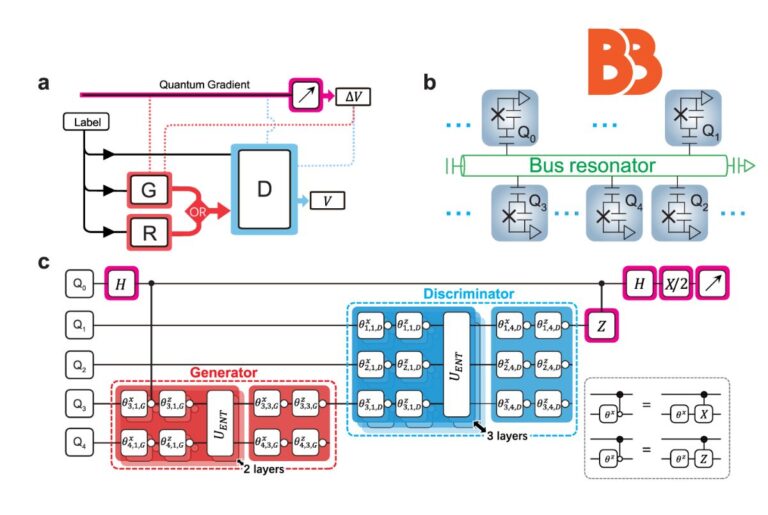Quantum generative adversarial networks also known as QGANs are a new class of Quantum machine learning algorithms. That combine the efficiency of quantum computers with generative adversarial training. QGANs shall learn from a specified quantum data set of quantum states, measurements, circuits or opt to generate other quantum data. The specific uses of QGANs may include quantum simulation, quantum metrology, quantum cryptography. And quantum error correction in quantum information, science, and technology.
What QGANs are and how they operate?
QGANs are inspired by the classical generative adversarial networks (GANs), which are composed of two competing neural networks: There are two basic types of the neural network: a generator and a discriminator. The generator attempts at producing false data while it is distribution looks like the real data and the discriminator is responsible for identifying between real and the false data.
The common approach for training of such model is based on the adversarial process where the generator works against the discriminator, and the latter aims at distinguishing the faked samples. The training process is stopped when the generator’s and discriminator’s approximations are at the Nash equilibrium. Where the generator produces data that the discriminator cannot distinguish from the real data.
What are QGANs, why are they important?
QGANs have their significance because they can probably apply the benefits of quantum computing to generate quantum data superior in resemblance, variety and density to the real world. QGANs can also have advantages over classical GANs that were noted above. Such as mode collapse, gradient vanish, and instability during training due to the use of quantum properties of the generator and discriminator.
QGANs have many potential applications in various fields of quantum information, science, and technology, such as:
Quantum simulation
QGANs can be utilized to create quantum states with energies near the ground state or the evolution of various quantum systems. Such as molecular structures, materials, and lattices, without any additional heavy computation in quantum computing.
Quantum metrology
The developed Quantum Generative Adversarial Networks can serve to generate quantum states critical to improving the accuracy of quantum measurements. Like phase, frequency or magnetic field measurements without prior knowledge of these states or the measurement parameters.
Quantum cryptography
QGANs can be used for generating quantum states, which can increase the level of security in quantum communications. Like quantum key distribution, quantum secret sharing, or quantum digital signatures without using many resources or operations in the quantum field.
Quantum error correction
QGANs can be used to synthesize quantum states that cancel/compensate noise and decoherence in quantum technologies. Like quantum computers, quantum sensors, or quantum networks, without the need for big and bulky quantum error correction codes/schemes.
What are the difficulties and the directions for further research of QGANs?
QGANs are a new and exciting research area that poses many challenges and open problems, such as:
Scalability
Since the learning process in QGANs depends on the generation of two models, the generator and the discriminator. As well as the gradient circuit, and as the complexity of problem increases. It needs large and coherent quantum devices to perform the task. Which is not feasible in current or near future quantum computers. In the case of QGANs, one limitation is how to scale up the size as well as the complexity of the quantum data. And this may in fact necessitate new operators and formats of quantum data representations. As well as new compression techniques that allow for the expansion of QGANs.
Evaluation
In the case of QGANs, there is no unique measure to quantify the quality and the degree of the dispersion of the generative quantum data since the measurement can be task dependent. QGANs also have the problem of evaluating the quantum data distributions for comparison. Which can potentially be solved only with new appropriate quantum statistical or information-theoretic metrics.
Theory
QGANs have a poorly developed theoretical foundation where one is yet to develop a proper mathematical framework to understand the properties of the generator, discriminator or gradient circuit. Such as convergence, stability, robustness or the complexity of the model. QGANs also pose the following problem, To what extent can the amounts of quantum advantage or disadvantage made by QGANs compared with CGANs be defined or measured. Since the utilization of QGANs may introduce a new quantum complexity /computational model.
Conclusion
QGANs are a new promising field in quantum machine learning that can learn and generate realistic and diverse quantum data for use in quantum information, science, and technologies. As for Quantum Generative Adversarial Networks , it is a combination of the quantum computing and generative adversarial training networks. That learns from a given dataset of quantum examples to generate quantum data with statistically equivalent properties of the real quantum data.
Along with that, the use of quantum features of the generator and the discriminator makes it possible to eliminate. Some of the weaknesses inherent in the classical GANs and improve the quality and variety of quantum data. Due to some of the features of QGANs, it has several potential uses in quantum simulation, quantum measurement, quantum encryption, and quantum error correction. Among others in approximating, optimality, or improving the solution or the behavior of quantum systems or mod.
